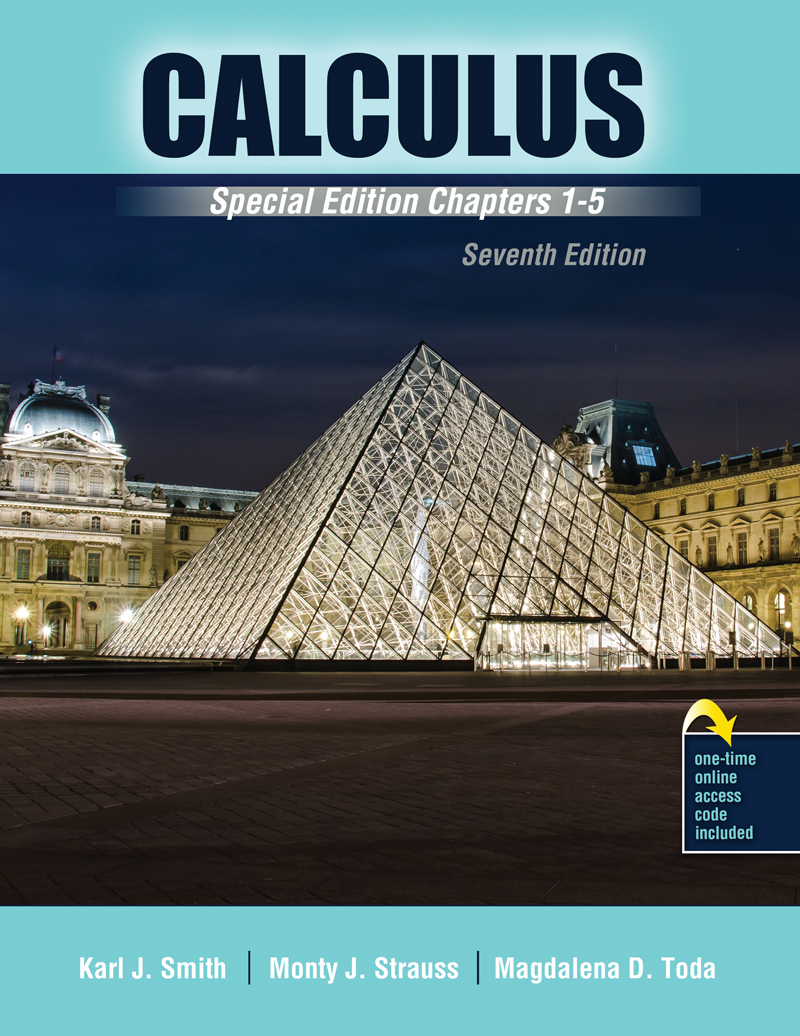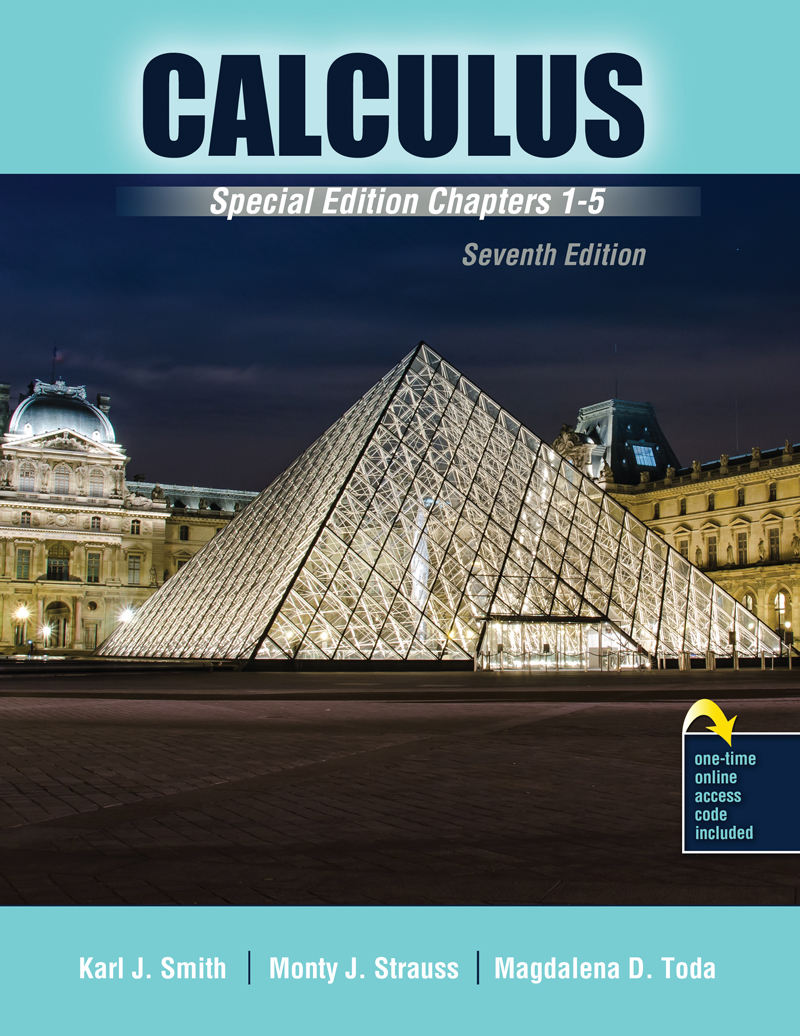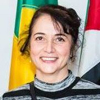Calculus: Special Edition: Chapters 1-5
Author(s): Karl J Smith , Monty Strauss , Magdalena Toda
Edition: 7
Copyright: 2018
Edition: 7
Copyright: 2018
Choose Your Format
Special Edition for Rutgers University
The NEW 7th edition of Calculus blends the best aspects of calculus reform along with the goals and methodology of traditional calculus. The format of this text is enhanced, but is not dominated by new technology. Its innovative presentation includes:
- Conceptual Understanding through Verbalization
- Mathematical Communication
- Cooperative Learning Group Research Projects
- Integration of Technology
- Greater Text Visualization
- Supplementary Materials
- Interactive art - Many pieces of art in the book link online to dynamic art to illustrate such topics as limits, slopes, areas, and direction fields
Calculus features:
- An early presentation of transcendental functions: Logarithms, exponential functions, and trigonometric functions
- Differential equations in a natural and reasonable way
- Utilization of the humanness of mathematics
- Precalculus mathematics being taught at most colleges and universities correctly reflected
- A student solutions manual, instructor’s manual, and accompanying website
It’s all about Problems, problems, problems, and even more problems:
- Modeling Problems require the reader to make assumptions about the real world.
- Think Tank Problems prove the proposition true or to find a counterexample to disprove the proposition.
- Exploration Problems go beyond the category of counterexample problem to provide opportunities for innovative thinking.
- Historical Quest Problems invite the students to participate in the historical development of mathematics. History becomes active rather than passive.
- Journal Problems have been reprinted from leading mathematics journals in an effort to show that “mathematicians work problems too.”
- Putnam Examination Problems have been included to challenge not only the “best of the best” but to offer stimulating content for everybody.
- Uniform Problem Sets 60 in every set allow for easy and consistent problem assignment.
- Cumulative Problem Sets for Chapters 1-5.
- Huge Chapter Supplementary Problem Set of 99 miscellaneous problems in each chapter.
- Proficiency Examination Problem Sets consisting of both concept and practice problems.
Preface
1 Functions and Graphs
1.1 What Is Calculus?
1.2 Preliminaries
1.3 Lines in the Plane; Parametric Equations
1.4 Functions and Graphs
1.5 Inverse Functions; Inverse Trigonometric Functions
Chapter 1 Review
Book Report Ethnomathematics by Marcia Ascher
Chapter 1 Group Research Project
2 Limits and Continuity
2.1 The Limit of a Function
2.2 Algebraic Computation of Limits
2.3 Continuity
2.4 Exponential and Logarithmic Functions
Chapter 2 Review
Chapter 2 Group Research Project
3 Differentiation
3.1 An Introduction to the Derivative: Tangents
3.2 Techniques of Differentiation
3.3 Derivatives of Trigonometric, Exponential, and Logarithmic Functions
3.4 Rates of Change: Modeling Rectilinear Motion
3.5 The Chain Rule
3.6 Implicit Differentiation
3.7 Related Rates and Applications
3.8 Linear Approximation and Differentials
Chapter 3 Review
Book Report Fermat’s Enigma by Simon Singh
Chapter 3 Group Research Project
4 Additional Applications of the Derivative
4.1 Extreme Values of a Continuous Function
4.2 The Mean Value Theorem
4.3 Using Derivatives to Sketch the Graph of a Function
4.4 Curve Sketching with Asymptotes: Limits Involving Infinity
4.5 l’Hˆopital’s Rule
4.6 Optimization in the Physical Sciences and Engineering
4.7 Optimization in Business, Economics, and the Life Sciences
Chapter 4 Review
Chapter 4 Group Research Project
5 Integration
5.1 Antidifferentiation
5.2 Area as the Limit of a Sum
5.3 Riemann Sums and the Definite Integral
5.4 The Fundamental Theorems of Calculus
5.5 Integration by Substitution
5.6 Introduction to Differential Equations
5.7 The Mean Value Theorem for Integrals; Average Value
5.8 Numerical Integration: The Trapezoidal Rule and Simpson’s Rule
5.9 An Alternative Approach: The Logarithm as an Integral
Chapter 5 Review
Chapter 5 Group Research Project
Cumulative Review Problems—Chapters 1–5
Appendices
A: Introduction to the Theory of Limits
B: Selected Proofs
C: Significant Digits
D: Short Table of Integrals
E: Trigonometry
F: Parabolas
G: Ellipses
H: Hyperbolas
I: Determinants
J: Answers to Selected Problems
Index
Karl J. Smith received his B.A. and M.A. degrees in mathematics from UCLA. In 1968, he moved to northern California to teach mathematics at Santa Rosa Junior College, where he taught until his retirement in 1993. Along the way, he served as department chair, and he received a Ph.D. in 1979 in mathematics education at Southeastern University. A past president of the American Mathematical Association of Two-Year Colleges, Professor Smith is active nationally in mathematics education. He was the founding editor of the Western AMATYC News, a chairperson of the Committee on Mathematics Excellence, and an NSF grant reviewer. In 1979 he received an Outstanding Young Men of America Award, in 1980 an Outstanding Educator Award, and in 1989 an Outstanding Teacher Award. Professor Smith is the author of over 60 successful textbooks. Over two million students have learned mathematics from his textbooks.
Monty Strauss has been on the mathematics faculty at Texas Tech University for almost forty years. He has a Ph.D. from the Courant Institute of Mathematical Sciences at New York University and has taught all levels of mathematics at Texas Tech, from precollege mathematics to doctoral level. He particularly has enjoyed working with honors students and with mathematics and engineering majors. Among his administrative assignments have been departmental undergraduate programs chair and departmental associate chair.
Magdalena Toda holds a PhD in Mathematics from University of Kansas and a PhD in Applied Mathematics from University Politehnica Bucharest. She is employed as a Professor of Mathematics at Texas Tech University, in Lubbock, TX, where she has served as interim chairperson between 2015-2016, and as department chairperson since 2016.
She has authored and co-authored 35 refereed articles, in the areas of differential geometry and geometric PDEs, and has served as an editor for a research monograph that appeared in 2017. She has extensive experience in teaching Calculus, in both the traditional, face-to-face format (since 1995), and online (since 2011). She is a recipient of 6 teaching awards (2 at University of Kansas and 4 at Texas Tech University - including the President's Award for Excellence in Teaching, 2008).
Special Edition for Rutgers University
The NEW 7th edition of Calculus blends the best aspects of calculus reform along with the goals and methodology of traditional calculus. The format of this text is enhanced, but is not dominated by new technology. Its innovative presentation includes:
- Conceptual Understanding through Verbalization
- Mathematical Communication
- Cooperative Learning Group Research Projects
- Integration of Technology
- Greater Text Visualization
- Supplementary Materials
- Interactive art - Many pieces of art in the book link online to dynamic art to illustrate such topics as limits, slopes, areas, and direction fields
Calculus features:
- An early presentation of transcendental functions: Logarithms, exponential functions, and trigonometric functions
- Differential equations in a natural and reasonable way
- Utilization of the humanness of mathematics
- Precalculus mathematics being taught at most colleges and universities correctly reflected
- A student solutions manual, instructor’s manual, and accompanying website
It’s all about Problems, problems, problems, and even more problems:
- Modeling Problems require the reader to make assumptions about the real world.
- Think Tank Problems prove the proposition true or to find a counterexample to disprove the proposition.
- Exploration Problems go beyond the category of counterexample problem to provide opportunities for innovative thinking.
- Historical Quest Problems invite the students to participate in the historical development of mathematics. History becomes active rather than passive.
- Journal Problems have been reprinted from leading mathematics journals in an effort to show that “mathematicians work problems too.”
- Putnam Examination Problems have been included to challenge not only the “best of the best” but to offer stimulating content for everybody.
- Uniform Problem Sets 60 in every set allow for easy and consistent problem assignment.
- Cumulative Problem Sets for Chapters 1-5.
- Huge Chapter Supplementary Problem Set of 99 miscellaneous problems in each chapter.
- Proficiency Examination Problem Sets consisting of both concept and practice problems.
Preface
1 Functions and Graphs
1.1 What Is Calculus?
1.2 Preliminaries
1.3 Lines in the Plane; Parametric Equations
1.4 Functions and Graphs
1.5 Inverse Functions; Inverse Trigonometric Functions
Chapter 1 Review
Book Report Ethnomathematics by Marcia Ascher
Chapter 1 Group Research Project
2 Limits and Continuity
2.1 The Limit of a Function
2.2 Algebraic Computation of Limits
2.3 Continuity
2.4 Exponential and Logarithmic Functions
Chapter 2 Review
Chapter 2 Group Research Project
3 Differentiation
3.1 An Introduction to the Derivative: Tangents
3.2 Techniques of Differentiation
3.3 Derivatives of Trigonometric, Exponential, and Logarithmic Functions
3.4 Rates of Change: Modeling Rectilinear Motion
3.5 The Chain Rule
3.6 Implicit Differentiation
3.7 Related Rates and Applications
3.8 Linear Approximation and Differentials
Chapter 3 Review
Book Report Fermat’s Enigma by Simon Singh
Chapter 3 Group Research Project
4 Additional Applications of the Derivative
4.1 Extreme Values of a Continuous Function
4.2 The Mean Value Theorem
4.3 Using Derivatives to Sketch the Graph of a Function
4.4 Curve Sketching with Asymptotes: Limits Involving Infinity
4.5 l’Hˆopital’s Rule
4.6 Optimization in the Physical Sciences and Engineering
4.7 Optimization in Business, Economics, and the Life Sciences
Chapter 4 Review
Chapter 4 Group Research Project
5 Integration
5.1 Antidifferentiation
5.2 Area as the Limit of a Sum
5.3 Riemann Sums and the Definite Integral
5.4 The Fundamental Theorems of Calculus
5.5 Integration by Substitution
5.6 Introduction to Differential Equations
5.7 The Mean Value Theorem for Integrals; Average Value
5.8 Numerical Integration: The Trapezoidal Rule and Simpson’s Rule
5.9 An Alternative Approach: The Logarithm as an Integral
Chapter 5 Review
Chapter 5 Group Research Project
Cumulative Review Problems—Chapters 1–5
Appendices
A: Introduction to the Theory of Limits
B: Selected Proofs
C: Significant Digits
D: Short Table of Integrals
E: Trigonometry
F: Parabolas
G: Ellipses
H: Hyperbolas
I: Determinants
J: Answers to Selected Problems
Index
Karl J. Smith received his B.A. and M.A. degrees in mathematics from UCLA. In 1968, he moved to northern California to teach mathematics at Santa Rosa Junior College, where he taught until his retirement in 1993. Along the way, he served as department chair, and he received a Ph.D. in 1979 in mathematics education at Southeastern University. A past president of the American Mathematical Association of Two-Year Colleges, Professor Smith is active nationally in mathematics education. He was the founding editor of the Western AMATYC News, a chairperson of the Committee on Mathematics Excellence, and an NSF grant reviewer. In 1979 he received an Outstanding Young Men of America Award, in 1980 an Outstanding Educator Award, and in 1989 an Outstanding Teacher Award. Professor Smith is the author of over 60 successful textbooks. Over two million students have learned mathematics from his textbooks.
Monty Strauss has been on the mathematics faculty at Texas Tech University for almost forty years. He has a Ph.D. from the Courant Institute of Mathematical Sciences at New York University and has taught all levels of mathematics at Texas Tech, from precollege mathematics to doctoral level. He particularly has enjoyed working with honors students and with mathematics and engineering majors. Among his administrative assignments have been departmental undergraduate programs chair and departmental associate chair.
Magdalena Toda holds a PhD in Mathematics from University of Kansas and a PhD in Applied Mathematics from University Politehnica Bucharest. She is employed as a Professor of Mathematics at Texas Tech University, in Lubbock, TX, where she has served as interim chairperson between 2015-2016, and as department chairperson since 2016.
She has authored and co-authored 35 refereed articles, in the areas of differential geometry and geometric PDEs, and has served as an editor for a research monograph that appeared in 2017. She has extensive experience in teaching Calculus, in both the traditional, face-to-face format (since 1995), and online (since 2011). She is a recipient of 6 teaching awards (2 at University of Kansas and 4 at Texas Tech University - including the President's Award for Excellence in Teaching, 2008).




